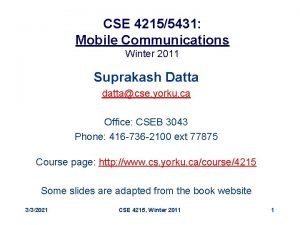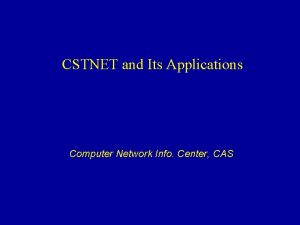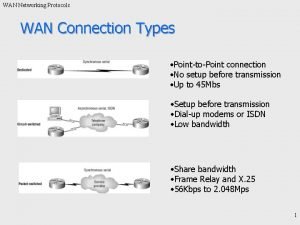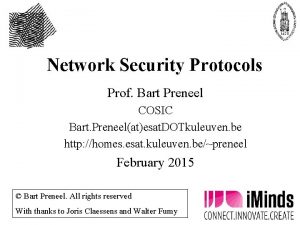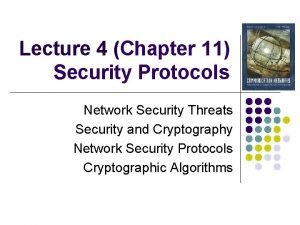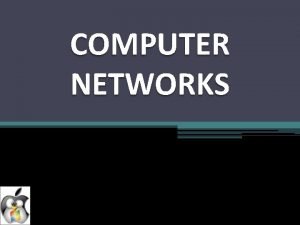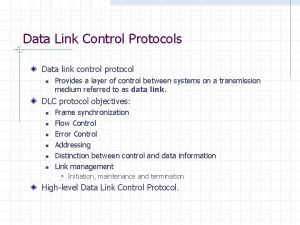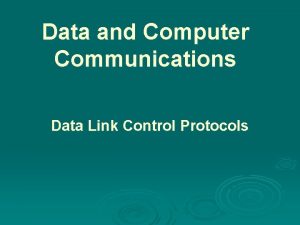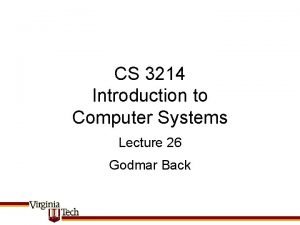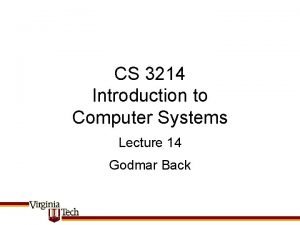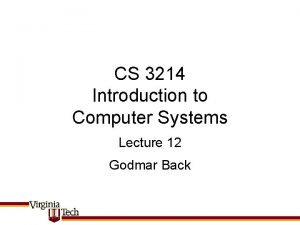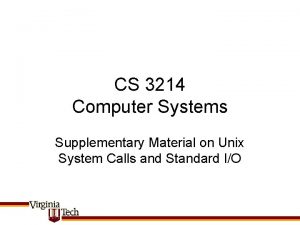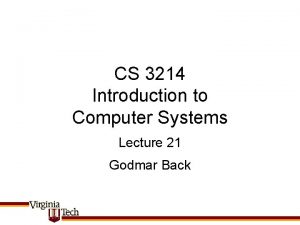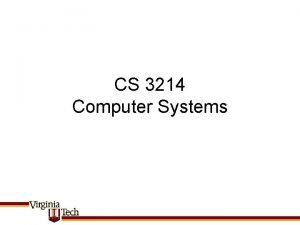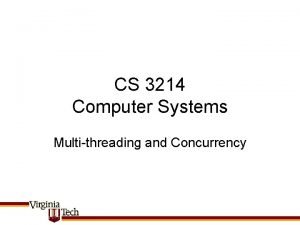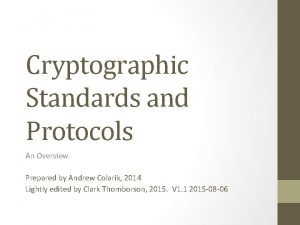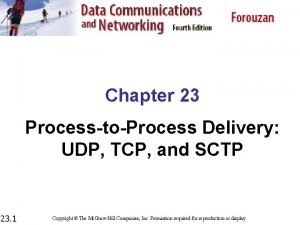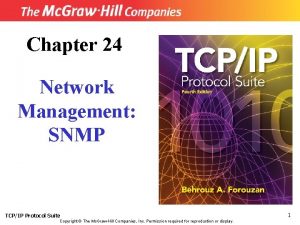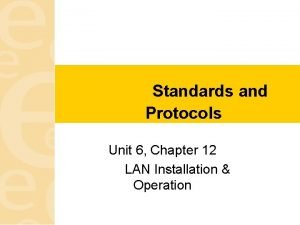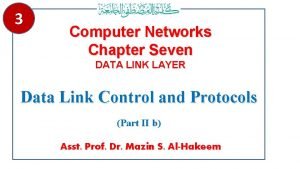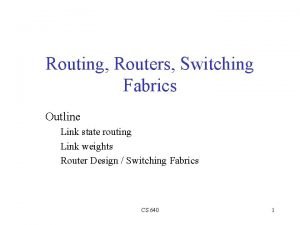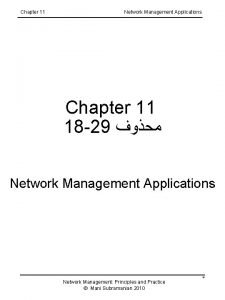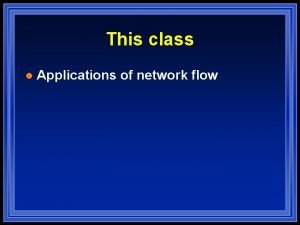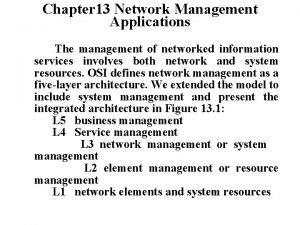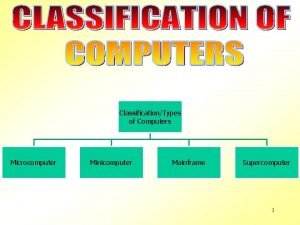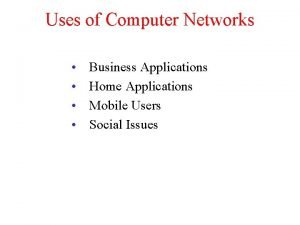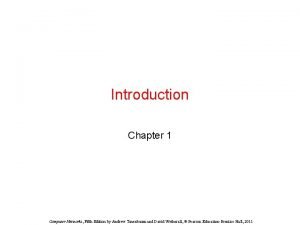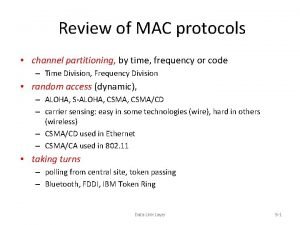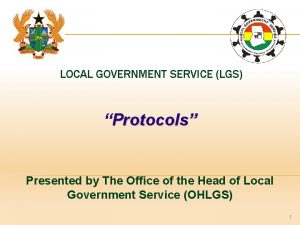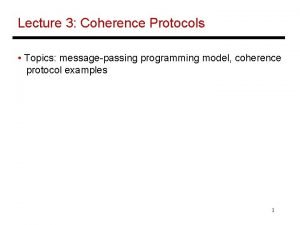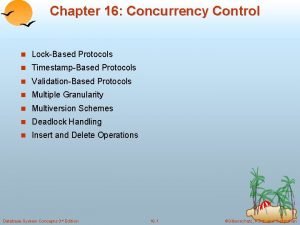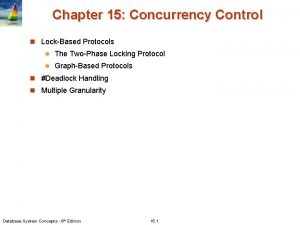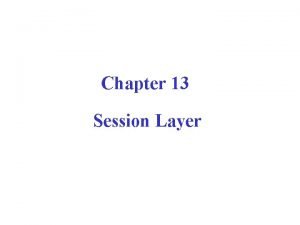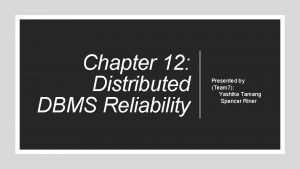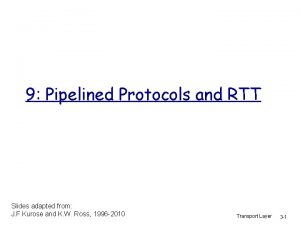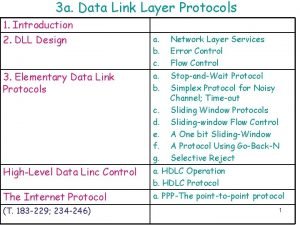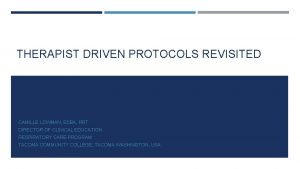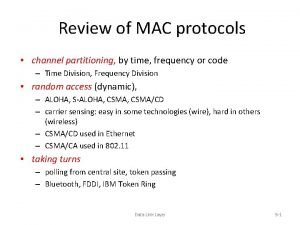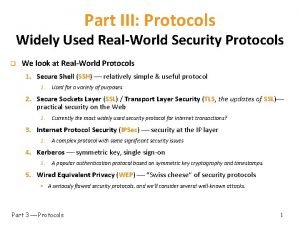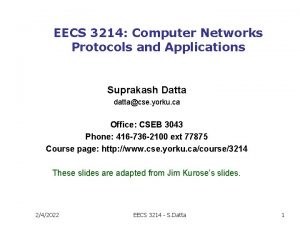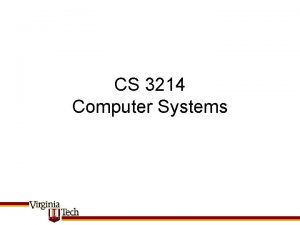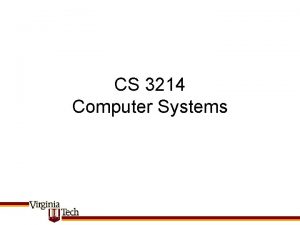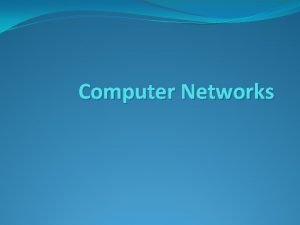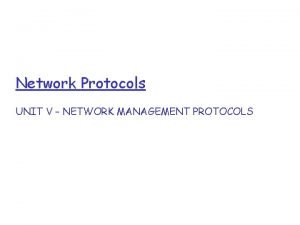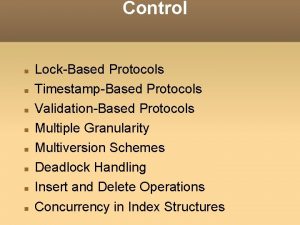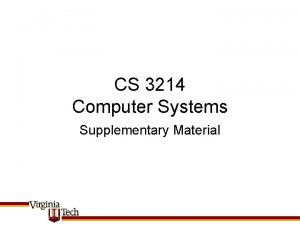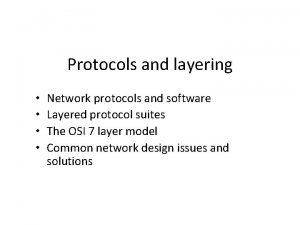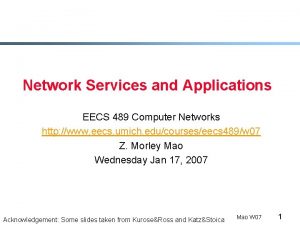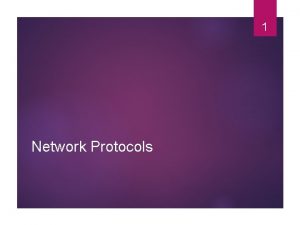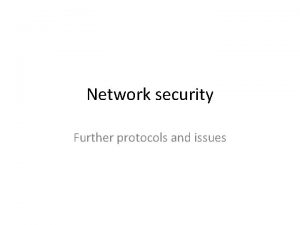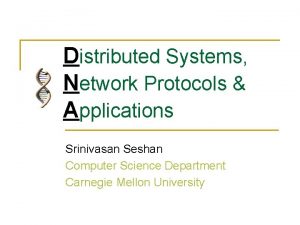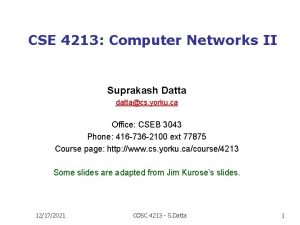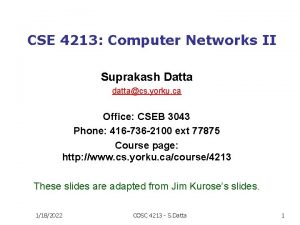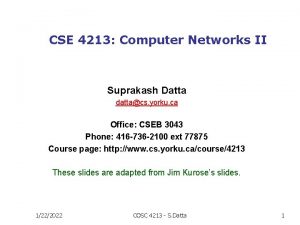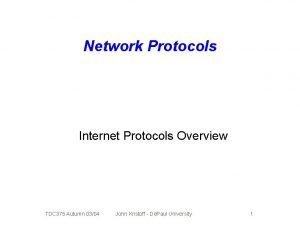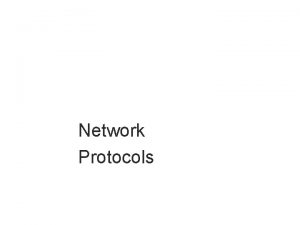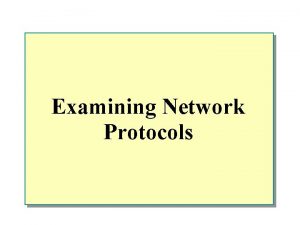EECS 3214 Computer Network Protocols and Applications Suprakash

















































![Electronic Mail: SMTP [RFC 2821] uses TCP to reliably transfer email message from client Electronic Mail: SMTP [RFC 2821] uses TCP to reliably transfer email message from client](https://slidetodoc.com/presentation_image/d1c5990fbca84908f4000d8d9c2f4dbd/image-50.jpg)





















- Slides: 71

EECS 3214: Computer Network Protocols and Applications Suprakash Datta datta@cse. yorku. ca Office: LAS 3043 Phone: 416 -736 -2100 ext 77875 Course page: http: //www. cse. yorku. ca/course/3214 These slides are adapted from Jim Kurose’s slides.

Chapter 2: Application layer 2. 1 Principles of network applications 2. 2 Web and HTTP 2. 3 FTP 2. 4 Electronic Mail SMTP, POP 3, IMAP 2. 5 DNS 2. 6 P 2 P file sharing socket programming with UDP and TCP 10/3/2020 EECS 3214 - S. Datta 2

Some network apps E-mail Web Instant messaging Remote login P 2 P file sharing Multi-user network games Streaming stored video clips Social networking 10/3/2020 Internet telephony Real-time video conference Massive parallel computing Search EECS 3214 - S. Datta 3

Creating a network app Write programs that run on different end systems and communicate over a network. e. g. , Web: Web server software communicates with browser software application transport network data link physical No software written for devices in network core Network core devices do not function at app layer This design allows for rapid app development 10/3/2020 application transport network data link physical EECS 3214 - S. Datta 4

Application architectures Client-server Peer-to-peer (P 2 P) Hybrid of client-server and P 2 P 10/3/2020 EECS 3214 - S. Datta 5

Client-server architecture server: always-on host permanent IP address server farms for scaling clients: communicate with server may be intermittently connected may have dynamic IP addresses do not communicate directly with each other 10/3/2020 EECS 3214 - S. Datta 6

Pure P 2 P architecture no always on server arbitrary end systems directly communicate peers are intermittently connected and change IP addresses Highly scalable: self scalability – new peers bring new service capacity, as well as new service demands But difficult to manage 10/3/2020 EECS 3214 - S. Datta 7

Hybrid of client-server and P 2 P Napster File transfer P 2 P File search centralized: Peers register content at central server Peers query same central server to locate content Instant messaging Chatting between two users is P 2 P Presence detection/location centralized: User registers its IP address with central server when it comes online User contacts central server to find IP addresses of buddies 10/3/2020 EECS 3214 - S. Datta 8

Processes communicating Process: program running within a host. within same host, two processes communicate using inter-process communication (defined by OS). processes in different hosts communicate by exchanging messages 10/3/2020 Client process: process that initiates communication Server process: process that waits to be contacted Note: applications with P 2 P architectures have client processes & server processes EECS 3214 - S. Datta 9

Sockets process sends/receives messages to/from its socket analogous to door sending process shoves message out door sending process relies on transport infrastructure on other side of door which brings message to socket at receiving process API: (1) choice of transport protocol; (2) ability to fix a few parameters (lots more on this later) application process application transport network physical controlled by app developer process transport link 10/3/2020 socket controlled by OS link Internet physical EECS 3214 - S. Datta 10

Addressing processes For a process to receive messages, it must have an identifier A host has a unique 32 bit IP address Q: does the IP address of the host on which the process runs suffice for identifying the process? Answer: No, many processes can be running on same host 10/3/2020 Identifier includes both the IP address and port numbers associated with the process on the host. Example port numbers: HTTP server: 80 Mail server: 25 More on this later EECS 3214 - S. Datta 11

App-layer protocol defines Types of messages exchanged, eg, request & response messages Syntax of message types: what fields in messages & how fields are delineated Semantics of the fields, ie, meaning of information in fields Rules for when and how processes send & respond to messages 10/3/2020 Public-domain protocols: defined in RFCs allows for interoperability eg, HTTP, SMTP Proprietary protocols: eg, Skype EECS 3214 - S. Datta 12

What transport service does an application need? Data integrity Throughput some apps (e. g. , file some apps (e. g. , transfer, web transactions) multimedia) require 100% reliable data minimum amount of transfer bandwidth to be other apps (e. g. , audio) can “effective” tolerate some loss other apps (“elastic apps”) make use of Timing whatever bandwidth they some apps (e. g. , get Internet telephony, interactive games) security require low delay to be encryption, data integrity, “effective” … 10/3/2020 EECS 3214 - S. Datta 13

Transport service requirements of common apps Data loss Bandwidth Time Sensitive file transfer e-mail Web documents real-time audio/video no loss-tolerant no no no yes, 100’s msec stored audio/video interactive games instant messaging loss-tolerant no loss elastic audio: 5 kbps-1 Mbps video: 10 kbps-5 Mbps same as above few kbps up elastic Application 10/3/2020 EECS 3214 - S. Datta yes, few secs yes, 100’s msec yes and no 14

Internet transport protocols services TCP service: UDP service: connection-oriented: setup required between client and server processes reliable transport between sending and receiving process flow control: sender won’t overwhelm receiver congestion control: throttle sender when network overloaded does not provide: timing, minimum bandwidth guarantees 10/3/2020 unreliable data transfer between sending and receiving process does not provide: connection setup, reliability, flow control, congestion control, timing, or bandwidth guarantee Q: why bother? Why is there a UDP? EECS 3214 - S. Datta 15

Internet apps: application, transport protocols Application e-mail remote terminal access Web file transfer streaming multimedia Internet telephony 10/3/2020 Application layer protocol Underlying transport protocol SMTP [RFC 2821] Telnet [RFC 854] HTTP [RFC 2616] FTP [RFC 959] HTTP (e. g. , You. Tube), RTP [RFC 1889] SIP, RTP, proprietary (e. g. , Skype) TCP TCP TCP or UDP EECS 3214 - S. Datta TCP or UDP 16

Securing TCP & UDP no encryption cleartext passwds sent into socket traverse Internet in cleartext SSL provides encrypted TCP connection data integrity end-point authentication 10/3/2020 SSL is at app layer Apps use SSL libraries, which “talk” to TCP SSL socket API cleartext passwds sent into socket traverse Internet encrypted See Chapter 7 EECS 3214 - S. Datta 17

Chapter 2: Application layer Next: Ch. 2. 2 Web and HTTP Examine the web infrastructure 10/3/2020 EECS 3214 - S. Datta 18

Web and HTTP First some jargon Web page consists of objects Object can be HTML file, JPEG image, Java applet, audio file, … Web page consists of base HTML-file which includes several referenced objects Each object is addressable by a URL Example URL: www. someschool. edu/some. Dept/pic. gif path name host name 10/3/2020 EECS 3214 - S. Datta 19

HTTP overview HTTP: hypertext transfer protocol Web’s application layer protocol client/server model client: browser that requests, receives, “displays” Web objects server: Web server sends objects in response to requests HTTP 1. 0: RFC 1945 HTTP 1. 1: RFC 2068 HT TP req ues H PC running TT t Pr Explorer esp ons e que e r TP HT n spo e r TP HT st Mac running Navigator 10/3/2020 EECS 3214 - S. Datta 20 se Server running Apache Web server

HTTP overview (continued) Uses TCP: HTTP is “stateless” server maintains no information about past client requests client initiates TCP connection (creates socket) to server, port 80 aside server accepts TCP Protocols that maintain connection from client “state” are complex! HTTP messages (application-layer protocol past history (state) must messages) exchanged be maintained between browser (HTTP if server/client crashes, client) and Web server their views of “state” (HTTP server) may be inconsistent, TCP connection closed must be reconciled 10/3/2020 EECS 3214 - S. Datta 21

HTTP connections Nonpersistent HTTP at most one object sent over TCP connection then closed downloading multiple objects required multiple connections Persistent HTTP Multiple objects can be sent over single TCP connection between client and server. HTTP/1. 1 uses persistent connections in default mode HTTP/1. 0 uses nonpersistent HTTP 10/3/2020 EECS 3214 - S. Datta 22

Nonpersistent HTTP Suppose user enters URL (contains text, references to 10 jpeg images) www. some. School. edu/cs/index. html 1 a. HTTP client initiates TCP connection to HTTP server (process) at www. some. School. edu on port 80 2. HTTP client sends HTTP request message (containing URL) into TCP connection socket. Message indicates that client wants object some. Department/home. index 1 b. HTTP server at host www. some. School. edu waiting for TCP connection at port 80. “accepts” connection, notifying client 3. HTTP server receives request message, forms response message containing requested object, and sends message into its socket time 10/3/2020 EECS 3214 - S. Datta 23

Nonpersistent HTTP (cont. ) 5. HTTP client receives response message containing html file, displays html. Parsing html file, finds 10 referenced jpeg objects time 4. HTTP server closes TCP connection. 6. Steps 1 -5 repeated for each of 10 jpeg objects 10/3/2020 EECS 3214 - S. Datta 24

Response time modeling Definition of RTT: time to send a small packet to travel from client to server and back. initiate TCP connection Response time: RTT one RTT to initiate TCP request connection file RTT one RTT for HTTP request and first few bytes of file HTTP response to return received file transmission time total = 2 RTT+transmit time 10/3/2020 EECS 3214 - S. Datta time to transmit file time 25

Persistent HTTP Nonpersistent HTTP issues: requires 2 RTTs per object OS must work and allocate host resources for each TCP connection but browsers often open parallel TCP connections to fetch referenced objects Persistent HTTP server leaves connection open after sending response subsequent HTTP messages between same client/server are sent over connection 10/3/2020 Persistent without pipelining: client issues new request only when previous response has been received one RTT for each referenced object Persistent with pipelining: default in HTTP/1. 1 client sends requests as soon as it encounters a referenced object as little as one RTT for all the referenced objects EECS 3214 - S. Datta 26

HTTP request message two types of HTTP messages: request, response HTTP request message: ASCII (human-readable format) carriage return character line-feed character request line (GET, POST, HEAD commands) carriage return, line feed at start of line indicates end of header lines 10/3/2020 GET /index. html HTTP/1. 1rn Host: www-net. cs. umass. edurn User-Agent: Firefox/3. 6. 10rn Accept: text/html, application/xhtml+xmlrn Accept-Language: en-us, en; q=0. 5rn Accept-Encoding: gzip, deflatern Accept-Charset: ISO-8859 -1, utf-8; q=0. 7rn Keep-Alive: 115rn Connection: keep-alivern EECS 3214 - S. Datta 27

HTTP request message: general format 10/3/2020 EECS 3214 - S. Datta 28

Uploading form input Post method: URL method: Web page often includes Uses GET method form input Input is uploaded in URL Input is uploaded to server field of request line: in entity body www. somesite. com/animalsearch? monkeys&banana 10/3/2020 EECS 3214 - S. Datta 29

Method types HTTP/1. 0 GET POST HEAD HTTP/1. 1 GET, POST, HEAD PUT asks server to leave requested object out of response 10/3/2020 uploads file in entity body to path specified in URL field DELETE deletes file specified in the URL field EECS 3214 - S. Datta 30

HTTP response message status line (protocol status code status phrase) header lines data, e. g. , requested HTML file 10/3/2020 HTTP/1. 1 200 OKrn Date: Sun, 26 Sep 2010 20: 09: 20 GMTrn Server: Apache/2. 0. 52 (Cent. OS)rn Last-Modified: Tue, 30 Oct 2007 17: 00: 02 GMTrn ETag: "17 dc 6 -a 5 c-bf 716880"rn Accept-Ranges: bytesrn Content-Length: 2652rn Keep-Alive: timeout=10, max=100rn Connection: Keep-Alivern Content-Type: text/html; charset=ISO 8859 -1rn data data. . . EECS 3214 - S. Datta 31

HTTP response status codes In first line in server->client response message. A few sample codes: 200 OK request succeeded, requested object later in this message 301 Moved Permanently requested object moved, new location specified later in this message (Location: ) 400 Bad Request request message not understood by server 404 Not Found requested document not found on this server 505 HTTP Version Not Supported 10/3/2020 EECS 3214 - S. Datta 32

Trying out HTTP (client side) for yourself 1. Telnet to your favorite Web server: telnet cis. poly. edu 80 Opens TCP connection to port 80 (default HTTP server port) at cis. poly. edu. Anything typed in sent to port 80 at cis. poly. edu 2. Type in a GET HTTP request: GET /~ross/ HTTP/1. 1 Host: cis. poly. edu By typing this in (hit carriage return twice), you send this minimal (but complete) GET request to HTTP server 3. Look at response message sent by HTTP server! (or use Wireshark to look at captured HTTP request/response) 10/3/2020 EECS 3214 - S. Datta 33

User-server state: cookies Many major Web sites use cookies Four components: 1) cookie header line in the HTTP response message 2) cookie header line in HTTP request message 3) cookie file kept on user’s host and managed by user’s browser 4) back-end database at Web site 10/3/2020 Example: Susan access Internet always from same PC She visits a specific ecommerce site for first time When initial HTTP requests arrives at site, site creates a unique ID and creates an entry in backend database for ID EECS 3214 - S. Datta 34

Cookies: keeping “state” (cont. ) client ebay: 8734 Cookie file amazon: 1678 ebay: 8734 usual http request msg usual http response + Set-cookie: 1678 usual http request msg cookie: 1678 usual http response msg Cookie file amazon: 1678 ebay: 8734 10/3/2020 cookiespecific action ss acce ac ce one week later: e n server da try i tab n b creates ID as ac e ke nd 1678 for user ss Cookie file server usual http request msg cookie: 1678 usual http response msg cookiespectific action EECS 3214 - S. Datta 35

Cookies (continued) What cookies can bring: authorization shopping carts recommendations user session state (Web email) how to keep “state”: protocol endpoints: maintain state at sender/receiver over multiple transactions cookies: http messages carry state 10/3/2020 aside Cookies and privacy: cookies permit sites to learn a lot about you may supply name and e-mail to sites search engines use redirection & cookies to learn yet more advertising companies obtain info across sites EECS 3214 - S. Datta 36

Web caches (proxy server) Goal: satisfy client request without involving origin server user sets browser: Web accesses via cache browser sends all HTTP requests to cache origin server HT TP r Proxy server object in cache: cache equ HT est client TP returns object res pon se else cache requests est u q object from origin server, re P nse T o p then returns object to HT es r TP client T H est u q e Pr T nse o p HT res P T HT client 10/3/2020 EECS 3214 - S. Datta origin server 37

More about Web caching Cache acts as both client and server for original requesting client to origin server Typically cache is installed by ISP (university, company, residential ISP) 10/3/2020 Why Web caching? Reduce response time for client request. Reduce traffic on an institution’s access link. Internet dense with caches enables “poor” content providers to effectively deliver content (but so does P 2 P file sharing) EECS 3214 - S. Datta 38

Caching example Assumptions average object size = 100, 000 bits avg. request rate from institution’s browsers to origin servers = 15/sec delay from institutional router to any origin server and back to router = 2 sec Consequences utilization on LAN = 15% utilization on access link = 100% total delay = Internet delay + access delay + LAN delay = 2 sec + minutes + milliseconds origin servers public Internet 1. 5 Mbps access link institutional network 10/3/2020 EECS 3214 - S. Datta 10 Mbps LAN institutional cache 39

Caching example (cont) Possible solution increase bandwidth of access link to, say, 10 Mbps Consequences utilization on LAN = 10% utilization on access link = 100% Total delay = Internet delay + access delay + LAN delay = 2 sec + msecs often a costly upgrade origin servers public Internet 100 Mbps access link institutional network 1 Gbps LAN institutional cache 10/3/2020 EECS 3214 - S. Datta 40

Caching example (cont) Install local cache origin servers suppose hit rate is. 4 Consequence 40% requests will be satisfied almost immediately 60% requests satisfied by origin server utilization of access link reduced to 60%, resulting in negligible delays (say 10 msec) total avg delay = Internet delay + access delay + LAN delay =. 6*(2. 01) secs + milliseconds < 1. 4 secs public Internet 1. 5 Mbps access link institutional network institutional cache Cheap! 10/3/2020 10 Mbps LAN EECS 3214 - S. Datta 41

Conditional GET Goal: don’t send object if cache has up-to-date cached version HTTP request msg If-modified-since: cache: specify date of <date> cached copy in HTTP request HTTP response server: response contains no object if cached copy is up-to-date: HTTP/1. 0 304 Not Modified HTTP request msg If-modified-since: <date> HTTP response HTTP/1. 0 200 OK <data> 10/3/2020 object not modified HTTP/1. 0 304 Not Modified If-modified-since: <date> server EECS 3214 - S. Datta 42 object modified

Chapter 2: Application layer Next application: Ch 2. 3 FTP Note the fundamental differences between HTTP and FTP, especially regarding maintaining per-session state. 10/3/2020 EECS 3214 - S. Datta 43

FTP: the file transfer protocol user at host FTP user client interface file transfer FTP server remote file system local file system transfer file to/from remote host client/server model client: side that initiates transfer (either to/from remote) server: remote host ftp: RFC 959 ftp server: port 21 10/3/2020 EECS 3214 - S. Datta 44

FTP: separate control, data connections FTP client contacts FTP server at port 21, specifying TCP as TCP control connection transport protocol port 21 Client obtains authorization over control connection TCP data connection FTP Client browses remote directory port 20 client server by sending commands over control connection. When server receives a command Server opens a second TCP data connection to transfer for a file transfer, the server opens another file. a TCP data connection to client After transferring one file, server Control connection: “out of band” closes connection. FTP server maintains “state”: current directory, earlier authentication 10/3/2020 EECS 3214 - S. Datta 45

FTP commands, responses Sample commands: Sample return codes sent as ASCII text over control channel USER username PASS password LIST return list of file in current directory RETR filename retrieves (gets) file STOR filename stores (puts) file onto remote host 10/3/2020 status code and phrase (as in HTTP) 331 Username OK, password required 125 data connection already open; transfer starting 425 Can’t open data connection 452 Error writing file EECS 3214 - S. Datta 46

Chapter 2: Application layer 2. 1 Principles of network applications 2. 2 Web and HTTP 2. 3 FTP 2. 4 Electronic Mail SMTP, POP 3, IMAP 2. 5 DNS 10/3/2020 2. 6 P 2 P file sharing 2. 7 Socket programming with TCP 2. 8 Socket programming with UDP 2. 9 Building a Web server CSE 3214 - S. Datta 47

Electronic Mail outgoing message queue Three major components: user agents mail servers simple mail transfer protocol: SMTP user mailbox user agent mail server User Agent a. k. a. “mail reader” SMTP composing, editing, reading mail messages mail e. g. , Eudora, Outlook, elm, server Netscape Messenger outgoing, incoming messages stored on server user agent 10/3/2020 CSE 3214 - S. Datta SMTP user agent mail server SMTP user agent 48

Electronic Mail: mail servers Mail Servers mailbox contains incoming messages for user message queue of outgoing (to be sent) mail messages SMTP protocol between mail servers to send email messages client: sending mail server “server”: receiving mail server user agent mail server SMTP mail server user agent 10/3/2020 CSE 3214 - S. Datta SMTP user agent 49 user agent mail server user agent
![Electronic Mail SMTP RFC 2821 uses TCP to reliably transfer email message from client Electronic Mail: SMTP [RFC 2821] uses TCP to reliably transfer email message from client](https://slidetodoc.com/presentation_image/d1c5990fbca84908f4000d8d9c2f4dbd/image-50.jpg)
Electronic Mail: SMTP [RFC 2821] uses TCP to reliably transfer email message from client to server, port 25 direct transfer: sending server to receiving server three phases of transfer handshaking (greeting) transfer of messages closure command/response interaction commands: ASCII text response: status code and phrase messages must be in 7 -bit ASCII 10/3/2020 CSE 3214 - S. Datta 50

Scenario: Alice sends message to Bob 1) Alice uses UA to compose message and “to” bob@someschool. edu 4) SMTP client sends Alice’s message over the TCP connection 5) Bob’s mail server places the message in Bob’s mailbox 6) Bob invokes his user agent to read message 2) Alice’s UA sends message to her mail server; message placed in message queue 3) Client side of SMTP opens TCP connection with Bob’s mail server 1 user agent 10/3/2020 2 mail server 3 mail server 4 5 CSE 3214 - S. Datta 6 user agent 51

Sample SMTP interaction S: C: S: C: C: C: S: 220 hamburger. edu HELO crepes. fr 250 Hello crepes. fr, pleased to meet you MAIL FROM: <alice@crepes. fr> 250 alice@crepes. fr. . . Sender ok RCPT TO: <bob@hamburger. edu> 250 bob@hamburger. edu. . . Recipient ok DATA 354 Enter mail, end with ". " on a line by itself Do you like ketchup? How about pickles? . 250 Message accepted for delivery QUIT 221 hamburger. edu closing connection 10/3/2020 CSE 3214 - S. Datta 52

Try SMTP interaction for yourself: telnet servername 25 see 220 reply from server enter HELO, MAIL FROM, RCPT TO, DATA, QUIT commands above lets you send email without using email client (reader) 10/3/2020 CSE 3214 - S. Datta 53

SMTP: final words SMTP uses persistent connections SMTP requires message (header & body) to be in 7 -bit ASCII SMTP server uses CRLF to determine end of message Comparison with HTTP: 10/3/2020 HTTP: pull SMTP: push both have ASCII command/response interaction, status codes HTTP: each object encapsulated in its own response msg SMTP: multiple objects sent in multipart msg CSE 3214 - S. Datta 54

Mail message format SMTP: protocol for exchanging email msgs RFC 822: standard for text message format: header lines, e. g. , To: From: Subject: different from SMTP commands! header body the “message”, ASCII characters only 10/3/2020 CSE 3214 - S. Datta 55 blank line

Message format: multimedia extensions MIME: multimedia mail extension, RFC 2045, 2056 additional lines in msg header declare MIME content type MIME version method used to encode data multimedia data type, subtype, parameter declaration encoded data 10/3/2020 From: alice@crepes. fr To: bob@hamburger. edu Subject: Picture of yummy crepe. MIME-Version: 1. 0 Content-Transfer-Encoding: base 64 Content-Type: image/jpeg base 64 encoded data. . . . . base 64 encoded data CSE 3214 - S. Datta 56

Mail access protocols user agent SMTP sender’s mail server access protocol user agent receiver’s mail server SMTP: delivery/storage to receiver’s server Mail access protocol: retrieval from server POP: Post Office Protocol [RFC 1939] authorization (agent <-->server) and download IMAP: Internet Mail Access Protocol [RFC 1730] more features (more complex) manipulation of stored msgs on server HTTP: Hotmail , Yahoo! Mail, etc. 10/3/2020 CSE 3214 - S. Datta 57

POP 3 protocol authorization phase client commands: user: declare username pass: password server responses +OK -ERR transaction phase, client: list: list message numbers retr: retrieve message by number dele: delete quit 10/3/2020 S: C: S: +OK POP 3 server ready user bob +OK pass hungry +OK user successfully logged C: S: S: S: C: C: S: list 1 498 2 912. retr 1 <message 1 contents>. dele 1 retr 2 <message 1 contents>. dele 2 quit +OK POP 3 server signing off CSE 3214 - S. Datta 58 on

POP 3 (more) and IMAP More about POP 3 Previous example uses “download and delete” mode. Bob cannot re-read e-mail if he changes client “Download-and-keep”: copies of messages on different clients POP 3 is stateless across sessions 10/3/2020 IMAP Keep all messages in one place: the server Allows user to organize messages in folders IMAP keeps user state across sessions: names of folders and mappings between message IDs and folder name CSE 3214 - S. Datta 59

Chapter 2: Application layer 2. 1 Principles of network applications 2. 2 Web and HTTP 2. 3 FTP 2. 4 Electronic Mail SMTP, POP 3, IMAP 2. 5 DNS 10/3/2020 2. 6 P 2 P file sharing 2. 7 Socket programming with TCP 2. 8 Socket programming with UDP 2. 9 Building a Web server CSE 3214 - S. Datta 60

DNS: Domain Name System People: many identifiers: SSN, name, passport # Internet hosts, routers: IP address (32 bit) - used for addressing datagrams “name”, e. g. , ww. yahoo. com - used by humans Q: map between IP addresses and name ? 10/3/2020 Domain Name System: distributed database implemented in hierarchy of many name servers application-layer protocol host, routers, name servers to communicate to resolve names (address/name translation) note: core Internet function, implemented as applicationlayer protocol complexity at network’s “edge” CSE 3214 - S. Datta 61

DNS services Hostname to IP address translation Host aliasing Canonical and alias names Mail server aliasing Load distribution Why not centralize DNS? single point of failure traffic volume distant centralized database maintenance doesn’t scale! Replicated Web servers: set of IP addresses for one canonical name 10/3/2020 CSE 3214 - S. Datta 62

Distributed, Hierarchical Database Root DNS Servers com DNS servers yahoo. com amazon. com DNS servers org DNS servers pbs. org DNS servers edu DNS servers poly. edu umass. edu DNS servers Client wants IP for www. amazon. com; 1 st approx: Client queries a root server to find com DNS server Client queries com DNS server to get amazon. com DNS server Client queries amazon. com DNS server to get IP address for www. amazon. com 10/3/2020 CSE 3214 - S. Datta 63

DNS: Root name servers contacted by local name server that can not resolve name root name server: contacts authoritative name server if name mapping not known gets mapping returns mapping to local name server a Verisign, Dulles, VA c Cogent, Herndon, VA (also Los Angeles) d U Maryland College Park, MD k RIPE London (also Amsterdam, g US Do. D Vienna, VA Frankfurt) Stockholm (plus 3 i Autonomica, h ARL Aberdeen, MD other locations) j Verisign, ( 11 locations) m WIDE Tokyo e NASA Mt View, CA f Internet Software C. Palo Alto, CA (and 17 other locations) 13 root name servers worldwide b USC-ISI Marina del Rey, CA l ICANN Los Angeles, CA 10/3/2020 CSE 3214 - S. Datta 64

TLD and Authoritative Servers Top-level domain (TLD) servers: responsible for com, org, net, edu, etc, and all top-level country domains uk, fr, ca, jp. Network solutions maintains servers for com TLD Educause for edu TLD Authoritative DNS servers: organization’s DNS servers, providing authoritative hostname to IP mappings for organization’s servers (e. g. , Web and mail). Can be maintained by organization or service provider 10/3/2020 CSE 3214 - S. Datta 65

Local Name Server Does not strictly belong to hierarchy Each ISP (residential ISP, company, university) has one. Also called “default name server” When a host makes a DNS query, query is sent to its local DNS server Acts as a proxy, forwards query into hierarchy. 10/3/2020 CSE 3214 - S. Datta 66

Example root DNS server 2 Host at cis. poly. edu wants IP address for gaia. cs. umass. edu 3 4 TLD DNS server 5 local DNS server dns. poly. edu 1 8 requesting host 7 6 authoritative DNS server dns. cs. umass. edu cis. poly. edu gaia. cs. umass. edu 10/3/2020 CSE 3214 - S. Datta 67

Recursive queries root DNS server recursive query: puts burden of name resolution on contacted name server heavy load? 2 3 7 6 TLD DNS serve iterated query: contacted server replies with name of server to contact “I don’t know this name, but ask this server” local DNS server dns. poly. edu 1 5 4 8 requesting host authoritative DNS server dns. cs. umass. edu cis. poly. edu gaia. cs. umass. edu 10/3/2020 CSE 3214 - S. Datta 68

DNS: caching and updating records once (any) name server learns mapping, it caches mapping cache entries timeout (disappear) after some time TLD servers typically cached in local name servers Thus root name servers not often visited update/notify mechanisms under design by IETF RFC 2136 http: //www. ietf. org/html. charters/dnsind-charter. html 10/3/2020 CSE 3214 - S. Datta 69

DNS records DNS: distributed db storing resource records (RR) RR format: (name, value, type, ttl) Type=A – name is hostname – value is IP address – name is alias name for some “cannonical” (the real) name www. ibm. com is really Type=NS servereast. backup 2. ibm. com name is domain (e. g. foo. com) value is IP address of authoritative name server for this domain 10/3/2020 Type=CNAME – value is cannonical name Type=MX – value is name of mailserver associated with name CSE 3214 - S. Datta 70

DNS protocol, messages DNS protocol : query and reply messages, both with same message format msg header identification: 16 bit # for query, reply to query uses same # flags: query or reply recursion desired recursion available reply is authoritative 10/3/2020 CSE 3214 - S. Datta 71
 Eecs 3214
Eecs 3214 Suprakash datta
Suprakash datta Suprakash datta
Suprakash datta Cstnet
Cstnet Whats my ip
Whats my ip Chapter 3 network protocols and communications
Chapter 3 network protocols and communications Protocols and standards in computer networks
Protocols and standards in computer networks Principles of network applications in computer networks
Principles of network applications in computer networks Type
Type Network security protocols
Network security protocols Network security protocols
Network security protocols Wireless sensor network protocols
Wireless sensor network protocols Network communication protocols map
Network communication protocols map Utopian simplex protocol
Utopian simplex protocol Elementary data link protocols in computer networks
Elementary data link protocols in computer networks Data link control protocols in computer networks
Data link control protocols in computer networks Data link control protocols in computer networks
Data link control protocols in computer networks Cs 3214
Cs 3214 Cs 3214
Cs 3214 Cs 3214
Cs 3214 Cs 3214 fall 2021
Cs 3214 fall 2021 Cs 3214
Cs 3214 Cs 3214
Cs 3214 Cs 3214 vt
Cs 3214 vt Cs 3214
Cs 3214 Cs 3214
Cs 3214 Network topologies
Network topologies Computer networks and internets with internet applications
Computer networks and internets with internet applications Proofs of work and bread pudding protocols
Proofs of work and bread pudding protocols Introduction to wan technologies
Introduction to wan technologies Cryptography standards and protocols
Cryptography standards and protocols Tcp and sctp are both layer protocols
Tcp and sctp are both layer protocols Snmp port number
Snmp port number Lan standards and protocols
Lan standards and protocols Lab 4-1: routing concepts and protocols
Lab 4-1: routing concepts and protocols Data link layer protocols for noisy and noiseless channels
Data link layer protocols for noisy and noiseless channels Routing and switching protocols
Routing and switching protocols Routing and switching protocols
Routing and switching protocols Routing and switching protocols
Routing and switching protocols Plc norms
Plc norms Principles of network applications
Principles of network applications Network management applications
Network management applications Network flow applications
Network flow applications Network management applications
Network management applications Uses of computer networks in business applications
Uses of computer networks in business applications Discrete math tutor
Discrete math tutor Applications of mini computer
Applications of mini computer Objectives of computer applications
Objectives of computer applications Computer integrated manufacturing applications
Computer integrated manufacturing applications Elements of a computer
Elements of a computer Business application in computer network
Business application in computer network Business applications of computer networks
Business applications of computer networks A switch in a datagram network uses
A switch in a datagram network uses Features of peer to peer network and client server network
Features of peer to peer network and client server network Network centric computing
Network centric computing Channel partitioning mac protocols
Channel partitioning mac protocols Presentation layer protocols
Presentation layer protocols Local government service protocols
Local government service protocols Cache coherence protocols
Cache coherence protocols Define nursing protocols
Define nursing protocols Communication protocols for rpc
Communication protocols for rpc What is control m
What is control m Graph based locking protocol
Graph based locking protocol What are two pitfalls (problems) of lock-based protocols
What are two pitfalls (problems) of lock-based protocols Session layer function
Session layer function Reliability concepts and measures in distributed database
Reliability concepts and measures in distributed database Pipelining protocol
Pipelining protocol Stop-and-wait arq
Stop-and-wait arq Therapist driven protocols
Therapist driven protocols Gfta bell curve
Gfta bell curve Channel partitioning protocols
Channel partitioning protocols Real world protocols
Real world protocols


